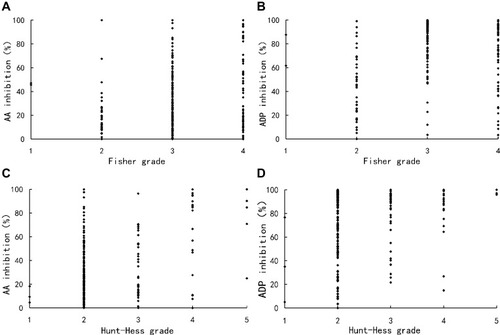Figures & data
Figure 1 Explanation of TEG and TEG-PM. (A) TEG parameters: K, Angle, MA, EPL and LY30. (B), TEG-PM parameters: MAThrombin, MAADP/AA, and MAFibrin. R, reaction time to clot formation; K, clotting time until 20-mm amplitude is achieved; Angle, time to reach a maximum speed of initial clot formation.

Table 1 Patient Characteristics
Table 2 Platelet Count and TEG-PM Parameters in Controls and Subarachnoid Hemorrhage Patients Stratified by Neurological Severity
Figure 2 Scatter plots showing the correlations between the degree of pathway inhibition and clinical grades. (A) AA inhibition was significantly correlated with Fisher grade (Spearman’s r=0.169, P=0.008); (B) ADP inhibition was significantly correlated with Fisher grade (Spearman’s r=0.233, P<0.001); (C) AA inhibition was significantly correlated with Hunt–Hess grade (Spearman’s r=0.264, P<0.001); (D) ADP inhibition was significantly correlated with Hunt–Hess grade (Spearman’s r=0.183, P=0.004).

Table 3 Comparison of Baseline Demographic, Clinical Characteristics and TEG-PM Parameters Between Patients with and Without Rebleeding
Table 4 Multivariate Analysis for Risk Factors of Rebleeding
